
It seems that substantial remains of Fort Pitt may have persisted into the 1830s. In 1836, William Gilman Lyford visited Pittsburgh, and was able to identify the blockhouse, which at that time had been turned into a private residence, among the lumberyards and workshops of what had become the less desirable section of the city. (Evidently he misremembered one letter of the inscription he read, or it was less legible then than it is now.) Other buildings nearby appeared to be of the same vintage; he speculated that they might have been officers’ quarters, which may well be true. After recounting the history of Fort Pitt, he continues with a description of the remains he found.
—
This garrison was kept up until 1763, and served as a Fort for the inhabitants, (for something like 200 had settled around it within the 2 or 3 preceding years,) to retire to on the breaking out of the Indian war of that year. Splendid gardens and orchards at that period, ornamented the sites where Liberty and Penn streets are now, and a noble row of brick and stone houses belonging to traders, lined the Allegheny’s banks; but they have nearly all been swept off, the latter by the undermining of the river, and the former to make room for the introduction of the mechanics’ workshops and the merchants’ warehouses.
A part of this Fort, however, so far as houses constitute a part, must yet be remaining; or a blockhouse and officers’ quarters must have been erected on or near the same spot, soon after the period last mentioned: for such buildings exist — they are of brick and two stories high; the former low pitched, adjoin each other, and carry in their appearance every thing of a military feature. The heavy timbers, in which the loop-holes are mortised, are on the sides next the city, about half the height of the building, and probably serve at this time to support the floor of the second story. A tabular stone, introduced just under the eaves, on the S. W. side of the building, contains the following inscription, verbatim, literatim, et punctuatim:
AD 1764.
COLL. BOSQUET.
I asked permission of the occupant, a pleasant looking German, whose name is John Martin, to enter his citadel, which he readily granted, and found the lower room tastefully finished and furnished; but he could give me no farther information, than that he had a lease on it at $40 a year. I suggested to him the advantages he might derive, by opening the room, (which is about 20 feet square,) during the season of travel, for the accommodation of strangers, and have in preparation some light cakes, lemonade, ices, fruits, &c. — for that numbers would be pleased to visit the military relic, if they could do so under circumstances other than intrusive, and while he obliged such he would profit liberally by the pleasant speculation. His wife just at this moment entered the room, laughing, from an adjoining shed, and wiping her arms, (for she appeared to have been washing,) “dare Jon, didn’t I dell de so, ofden ? hear vat de man say!” John laughed likewise, and replied “ah, I’ms doo old now; and pesides, yoo nose I cot vork petter dan dat.”
These buildings are located in the midst of lumber yards and workshops, very near the point at which the two rivers unite; but as it is difficult finding them, from the nature of the materials with which they are surrounded, some of which appear as ancient as the edifices themselves, it is probable that few other of the inhabitants are acquainted with their existence than those whose vocations call them into that section. It is a subject which at present does not interest business men. — The “Coll. Bosquet,” whose name is chiselled on the [s]tone plate, is doubtless the officer who commanded at Raystown, and contemporary with Washington some six or eight years previous; but how or where he took command of the fort in question, the inscription is the only data I can find upon the subject. —From The Western Address Directory, 1837.
